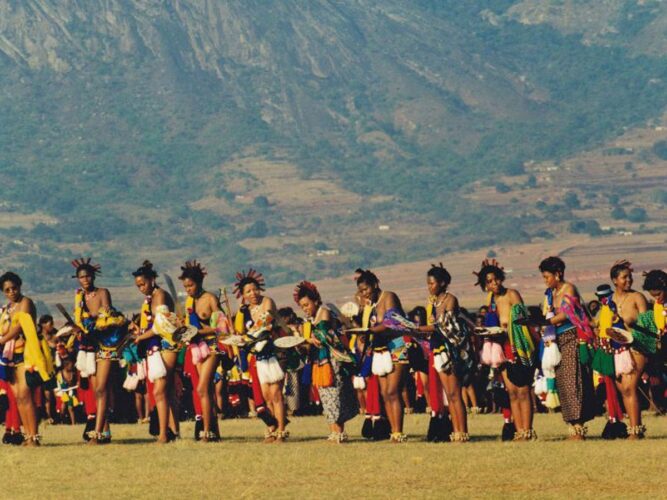Sign up to Simon Calder’s free travel email for expert advice and money-saving discountsGet Simon Calder’s Travel email
“You ask me what’s new?” The customs officer pondered my question. “Well,” he shrugged, gesturing at his uniform as though he’d expected by now to be somewhere else, “you still find me here”. Change in Swaziland is undeniably slow. Earlier this year, after 14 years away, I returned to the country to research a new guidebook. At the Ngwenya border post, arriving from Johannesburg, the faded posters on the walls looked distinctly familiar. As did the beaming portrait of King Mswati III, which depicted a considerably more youthful monarch than the portly figure who presides over his kingdom today.
And change, suggest critics, is what this place really needs. Now the only absolute monarchy in Africa, with political parties banned and the prime minister and cabinet appointed by the Labadzala – a council of royal elders – Swaziland is a political anachronism. The ruling elite, it is alleged, pursues an extravagant lifestyle while the nation slips further into poverty.
Yet upon entering the modern capital, Mbabane, where I watched an elderly chief stride past KFC decked in full leopard-skin lihiya loincloth, I was reminded that in this tiny kingdom the old ways have a stronger grip than outsiders may appreciate. Nowhere in southern Africa observes traditional culture more faithfully. Witness the Umhlanga, or reed dance: an annual week-long celebration of chastity, in which tens of thousands of unmarried girls converge on the royal parade grounds at Ludzidzini in an explosion of song, dance and costume. This is not something put on for tourists (even its date varies with ancestral astrology), but a genuine expression of cultural allegiances that still bind the nation. And attendance is rising every year.
You needn’t visit official festivals to see the strength of Swazi culture. Travel the rural areas and you’ll find mud-and-thatch homesteads built just as they have been for centuries. Modernity may have brought tin roofs and TV aerials, but the layout – one hut for each wife, one for brewing, one for the ancestral spirits and so on – is ancient. Most Swazis will still consult a sangoma (traditional healer) before turning to a Western-style doctor. And, only last year, a national scandal erupted when intruders buried muti – animal body parts used in rituals – beneath the turf of the national football stadium in an attempt to influence a forthcoming match.
Continuing north from Mbabane, it struck me that the paradoxical nature of Swaziland is embodied in its very landscape. At just 17,300sq km, the country is barely one-third bigger than Yorkshire: a mere postage stamp on the map of southern Africa. Yet once inside, it seems to open up like the Tardis, revealing massive, muscular panoramas that belie its bijou dimensions.
These panoramas are enormously varied, descending abruptly from the cool, rolling grasslands of the western “highveld” to the hot, dusty bush of the eastern “lowveld”, less than 100km away, a region described by Swazis as being “for fools and impala”. The former encompasses the wilderness of Malolotja Nature Reserve, where you can bathe beneath waterfalls and hike on remote trails for days, seeking out such special wildlife as the endangered blue swallow. The latter includes reserves such as Mkhaya and Hlane, where you can track rhinos, and other big game, through wild thorn bush, and swap tall campfire tales under the Southern Cross.
So, 14 years on, what is new? Certainly, I found that visitors are much better provided for. Better roads have brought the whole country to within two hours of Mbabane. Accommodation of all kinds, from backpacker hostels to swanky hotels, has proliferated. And it has become an adventure sports hotspot with caving, canopy ziplines and whitewater rafting all on the adrenalin menu.
Culturally, Swaziland is now also home to the Bushfire festival, a mini southern African Glastonbury that every May attracts artists from across the region. And the handicrafts industry – whose products, such as sisal baskets and soapstone carvings, now appear in ethnic boutiques well beyond the Swaziland borders – has got its act together, with some wonderful markets, roadside stalls and rural women’s cooperatives.
Yet the country remains dwarfed by the A-list attractions of neighbouring South Africa and Mozambique (and still confused with “Switzerland” by international postal services). This is good news for the visitor who dislikes a crowd. Climb Sibebe, the world’s second largest rock, or explore Ngwenya, the world’s oldest mine, and you’ll have these wonders pretty much to yourself.
Just three weeks ago, in a rush of progressive blood to the national head, Swaziland appointed Africa’s first female Anglican bishop. “It’s not easy to juggle my plates and balance two lives,” said Ellinah Wamukoya, her observation perfectly encapsulating the dilemma of her nation’s identity. “I know that the whole world is looking up to me to see if I will deliver.”
Who knows what will have been delivered next time I return? Swaziland is not a museum to be preserved for cultural historians. Yet, for the visitor, authentic Africa comes in no neater nutshell.
The Bradt Guide to Swaziland by Mike Unwin is out now (£15.99)
Travel Essentials
Getting there
Sense Africa (01275 877172; senseafrica.co.uk) has tailored self-drive safaris to Swaziland, with wildlife, culture and scenery. A 14-day trip starts at £2,850pp based on four travelling, including flights from London. Flights to Manzini are offered by South African Airways (0870 722 1111; flysaa.com) from Heathrow via Johannesburg.
More information
Swaziland Tourist Information: 0115 972 7250; thekingdomofswaziland.com
Source link : https://www.independent.co.uk/travel/africa/swaziland-africa-s-nutshell-nation-8390795.html
Author :
Publish date : 2012-12-07 08:00:00
Copyright for syndicated content belongs to the linked Source.
